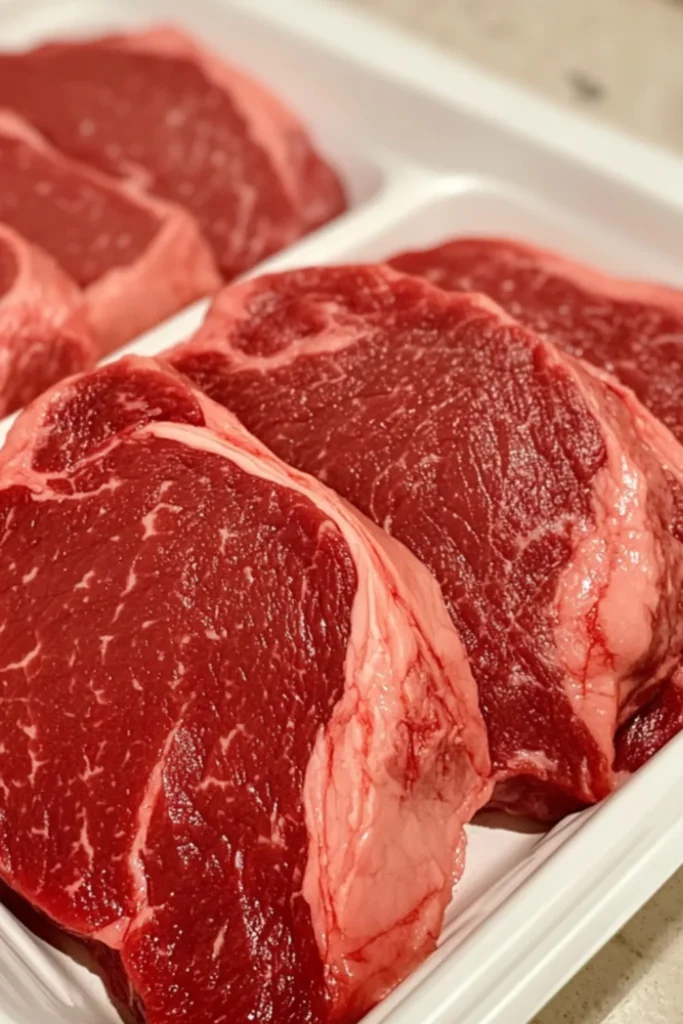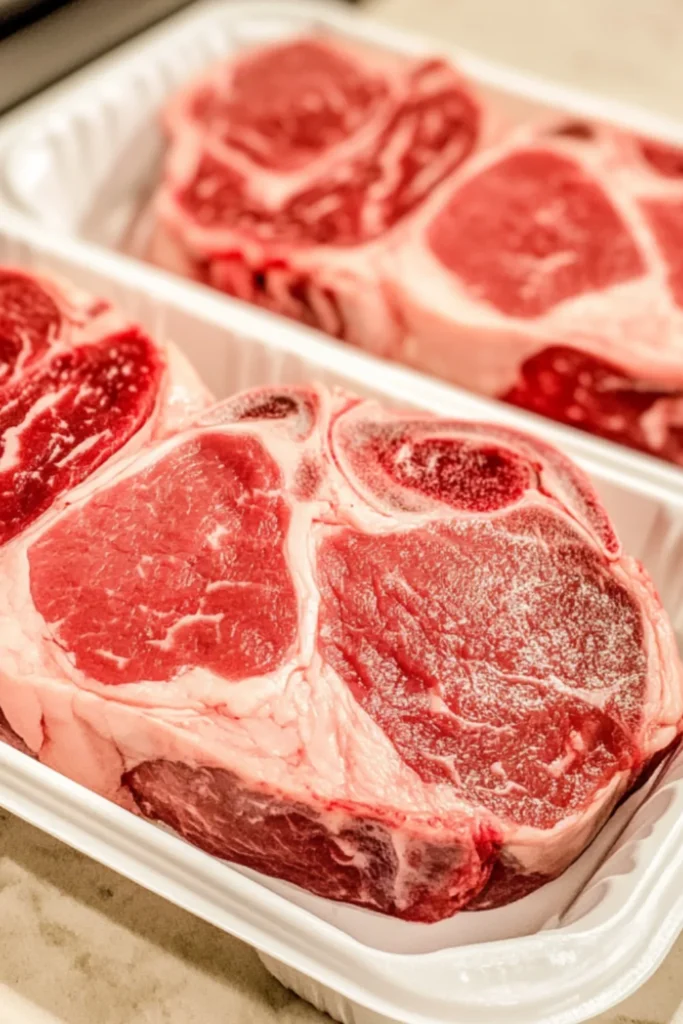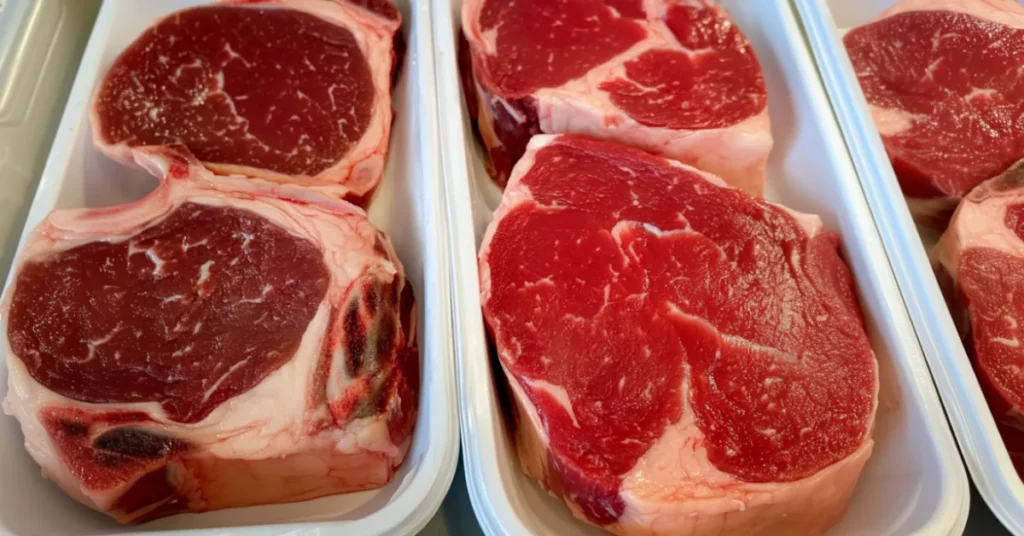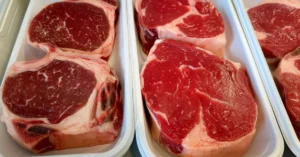Table of Contents
When it comes to steak, few debates are as heated as the one between NY Strip Steak and Ribeye. Both cuts are beloved by steak enthusiasts, but they each bring something unique to the table. Whether you’re a seasoned grill master or a casual home cook, understanding the differences between these two iconic cuts can elevate your dining experience.
In this article, we’ll dive deep into the world of NY Strip Steak and Ribeye, exploring their flavor profiles, textures, cooking methods, and more. By the end, you’ll know exactly which cut to choose for your next steak night—or maybe even be inspired to try both!
Introduction and Overview of NY Strip Steak vs Ribeye
Introduction to NY Strip Steak vs Ribeye
Let’s face it—choosing the perfect steak can feel like a daunting task, especially when you’re faced with options like NY Strip Steak and Ribeye. Both cuts are incredibly popular, but they cater to slightly different tastes and preferences.

NY Strip Steak, also known as Strip Steak or Kansas City Strip, is prized for its bold, beefy flavor and firm texture. On the other hand, Ribeye is celebrated for its rich marbling, buttery tenderness, and melt-in-your-mouth juiciness. So, which one should you choose? Well, that depends on what you’re looking for in a steak.
What is NY Strip Steak?
If you’re a fan of hearty, robust flavors, NY Strip Steak might just be your go-to cut. This steak comes from the short loin of the cow, a section known for producing tender, flavorful meat.
- Flavor: NY Strip Steak boasts a bold, beefy taste that’s slightly leaner than Ribeye.
- Texture: It has a firm, meaty texture with moderate marbling, making it less fatty than Ribeye but still incredibly satisfying.
- Appearance: Typically, it’s a well-shaped cut with a fat cap along one edge, which adds flavor during cooking.
Whether you’re grilling or pan-searing, NY Strip Steak is a versatile option that’s perfect for those who love a classic steak experience.
What is Ribeye Steak?
If richness and tenderness are what you’re after, Ribeye Steak is hard to beat. This cut comes from the rib section of the cow, which is known for its abundant marbling and fat content.
- Flavor: Ribeye is rich, buttery, and packed with flavor, thanks to its high fat content.
- Texture: It’s incredibly tender and juicy, with a melt-in-your-mouth quality that’s hard to resist.
- Appearance: Ribeye is easily recognizable by its generous marbling and often includes a fat cap or “eye” of fat in the center.
For those who crave a luxurious, indulgent steak experience, Ribeye is the clear winner.
Why Compare NY Strip Steak vs Ribeye?
So, why bother comparing these two cuts? Well, understanding their differences can help you make the best choice for your meal. Whether you’re planning a special dinner or just craving a delicious steak, knowing the strengths of each cut ensures you’ll get exactly what you’re looking for.
- For Home Cooks: Learn which cut works best for your preferred cooking method.
- For Steak Enthusiasts: Discover new ways to enjoy your favorite cuts.
- For Foodies: Explore the nuances of flavor, texture, and presentation.
Detailed Comparison of NY Strip Steak and Ribeye
Now that we’ve introduced NY Strip Steak and Ribeye, it’s time to dig deeper into what sets these two cuts apart. From flavor and texture to marbling and cooking methods, this section will give you a clear understanding of how these steaks compare—and which one might suit your taste buds best.
Flavor Profile
When it comes to flavor, NY Strip Steak and Ribeye each bring something unique to the table.
- NY Strip Steak: Known for its bold, beefy flavor, NY Strip is a favorite among those who love a classic steak taste. It’s slightly leaner than Ribeye, which means it has a more pronounced meaty flavor without being overly rich.
- Ribeye Steak: If you’re after a richer, more indulgent experience, Ribeye is the way to go. Its high fat content and marbling give it a buttery, melt-in-your-mouth flavor that’s hard to resist.
Pro Tip: If you’re someone who enjoys savoring every bite, Ribeye’s luxurious flavor might win you over. But if you prefer a straightforward, hearty steak, NY Strip is your best bet.
Texture and Tenderness
Texture is another key factor that sets these two cuts apart.
- NY Strip Steak: With a firmer, meatier texture, NY Strip offers a satisfying chew that’s perfect for those who enjoy a more substantial bite. It’s tender but not as soft as Ribeye, making it a great choice for grilling or pan-searing.
- Ribeye Steak: Thanks to its abundant marbling, Ribeye is incredibly tender and juicy. The fat melts during cooking, creating a luxurious, melt-in-your-mouth experience that’s hard to beat.
Fun Fact: The fat cap on a Ribeye not only adds flavor but also helps keep the steak moist during cooking, making it a favorite for grilling enthusiasts.
Marbling and Fat Content
Marbling—the white flecks of fat within the muscle—plays a huge role in the flavor and texture of a steak.
- NY Strip Steak: While it has moderate marbling, NY Strip is leaner compared to Ribeye. This makes it a slightly healthier option for those watching their fat intake.
- Ribeye Steak: Known for its high marbling, Ribeye is packed with fat that melts during cooking, infusing the meat with rich, buttery flavor.
Did You Know? The marbling in Ribeye is what gives it that signature juiciness and tenderness, making it a top choice for steak lovers.
Cooking Methods
Both cuts are versatile, but they each shine with specific cooking techniques.
- NY Strip Steak:
- Grilling: Perfect for achieving a nice char and smoky flavor.
- Pan-Searing: Ideal for creating a crispy crust while keeping the inside juicy.
- Oven-Roasting: Great for thicker cuts, ensuring even cooking.
- Ribeye Steak:
- Grilling: The fat content makes it ideal for high-heat cooking, creating a delicious crust.
- Sous Vide: Ensures even cooking and maximum tenderness.
- Reverse Sear: Perfect for achieving a perfect medium-rare with a crispy exterior.
Pro Tip: For Ribeye, let the fat render properly during cooking to enhance its flavor and juiciness.
Price and Availability
When it comes to cost, there’s a noticeable difference between the two cuts.
- NY Strip Steak: Generally more affordable than Ribeye, making it a great option for budget-conscious steak lovers.
- Ribeye Steak: Tends to be pricier due to its higher fat content and tenderness, but many consider it worth the splurge.
Both cuts are widely available at grocery stores and butcher shops, though Ribeye might be slightly harder to find in premium grades.
Nutritional Comparison
When choosing between NY Strip Steak and Ribeye, it’s not just about flavor and texture—nutritional value plays a big role too. In this section, we’ll break down the calories, fat content, and other nutritional aspects of these two popular cuts. Whether you’re watching your diet or just curious about what’s on your plate, this comparison will help you make an informed decision.
More recipes: 1/4 Sheet Cake Size
Nutritional Value of NY Strip Steak
Let’s start with NY Strip Steak, a leaner option that’s often favored by health-conscious steak lovers.
- Calories: A 3-ounce serving of NY Strip Steak contains around 180-200 calories, depending on the cut and preparation.
- Protein: Packed with about 25 grams of protein per serving, it’s a great choice for muscle repair and growth.
- Fat: With approximately 8-10 grams of fat, it’s leaner than Ribeye but still offers a satisfying richness.
- Other Nutrients: It’s a good source of iron, zinc, and B vitamins, which are essential for energy and overall health.
Pro Tip: If you’re looking for a high-protein, lower-fat option, NY Strip Steak is a solid pick. Just be mindful of portion sizes to keep calories in check.
Nutritional Value of Ribeye Steak
Now, let’s turn to Ribeye, the richer, more indulgent cousin of NY Strip.
- Calories: A 3-ounce serving of Ribeye Steak contains around 250-300 calories, thanks to its higher fat content.
- Protein: It offers a similar amount of protein as NY Strip—about 23-25 grams per serving.
- Fat: With 18-20 grams of fat, Ribeye is significantly richer, making it a more calorie-dense option.
- Other Nutrients: Like NY Strip, it’s rich in iron, zinc, and B vitamins, but the higher fat content adds extra flavor and juiciness.
Did You Know? The fat in Ribeye isn’t just about flavor—it also helps your body absorb fat-soluble vitamins like A, D, E, and K.
Which is Healthier?
So, which cut is the healthier choice? Well, it depends on your dietary goals.
- For Low-Fat Diets: NY Strip Steak is the clear winner, offering a leaner option with fewer calories and less fat.
- For Keto or High-Fat Diets: Ribeye Steak fits the bill, providing the fat content needed for these diets while still delivering plenty of protein.
- For Balanced Eating: Both cuts can be part of a healthy diet when enjoyed in moderation. Pair them with nutrient-rich sides like vegetables or a fresh salad to round out the meal.
Pro Tip: If you’re watching your sodium intake, be mindful of seasoning and sauces, as these can add extra sodium to your meal.
Cooking Tips and Techniques
Now that we’ve covered the basics of NY Strip Steak and Ribeye, it’s time to get cooking! Whether you’re a seasoned chef or a beginner in the kitchen, mastering the art of cooking these steaks will take your meals to the next level. In this section, we’ll explore the best methods for preparing each cut, along with tips for seasoning, resting, and slicing.
How to Cook NY Strip Steak
NY Strip Steak is a versatile cut that shines with a variety of cooking methods. Here’s how to make the most of it:
Grilling
- Preheat your grill to high heat (around 450°F).
- Season the steak generously with salt, pepper, and your favorite spices.
- Sear the steak for 3-4 minutes per side for medium-rare, or adjust the time based on your preferred doneness.
- Let it rest for 5 minutes before slicing.
Pro Tip: For extra flavor, add a pat of herb butter or a drizzle of olive oil after grilling.
Pan-Searing
- Heat a cast-iron skillet over medium-high heat and add a tablespoon of oil.
- Season the steak and sear it for 3-4 minutes per side.
- Add garlic, thyme, or rosemary to the pan for added aroma.
- Finish with a splash of butter and baste the steak for a minute before removing it from the heat.
Oven-Roasting
- Preheat your oven to 400°F.
- Sear the steak in a hot skillet for 2 minutes per side.
- Transfer the skillet to the oven and roast for 6-8 minutes, or until the desired doneness is reached.
How to Cook Ribeye Steak
Ribeye Steak is all about maximizing its rich flavor and tenderness. Here’s how to cook it to perfection:
Grilling
- Preheat your grill to medium-high heat.
- Season the steak and place it on the grill, fat-side down, to render the fat.
- Cook for 4-5 minutes per side for medium-rare, or adjust as needed.
- Let it rest for 5-10 minutes before serving.
Pro Tip: Use a meat thermometer to ensure the internal temperature reaches 130°F for medium-rare.
Sous Vide
- Season the steak and vacuum-seal it in a bag.
- Cook it in a sous vide water bath at 130°F for 1-2 hours.
- Sear the steak in a hot skillet or on the grill for 1-2 minutes per side to create a crust.
Reverse Sear
- Preheat your oven to 275°F.
- Season the steak and bake it until the internal temperature reaches 110°F.
- Finish by searing it in a hot skillet or on the grill for 1-2 minutes per side.
Seasoning and Marinades
Both cuts benefit from simple yet flavorful seasoning. Here are some ideas:
- NY Strip Steak: Stick to classic seasonings like salt, pepper, and garlic powder. For a twist, try a coffee rub or smoked paprika.
- Ribeye Steak: Enhance its natural richness with a herb butter marinade or a blend of rosemary, thyme, and garlic.
Pro Tip: Avoid over-marinating, as it can break down the meat’s texture. A simple dry rub or light marinade works best.
Resting and Slicing
No matter how you cook your steak, resting and slicing are crucial steps.
- Resting: Let the steak rest for 5-10 minutes after cooking. This allows the juices to redistribute, ensuring a moist and flavorful bite.
- Slicing: Cut against the grain for maximum tenderness. For Ribeye, slice through the fat cap to ensure even distribution of flavor.

Serving Suggestions and Pairings
A great steak deserves great sides! Whether you’re serving NY Strip Steak or Ribeye, the right accompaniments can elevate your meal from good to unforgettable. In this section, we’ll explore classic and creative side dishes, as well as wine and beverage pairings that complement each cut perfectly.
Best Side Dishes for NY Strip Steak
NY Strip Steak has a bold, beefy flavor that pairs well with a variety of sides. Here are some top picks:
- Mashed Potatoes: Creamy, buttery mashed potatoes are a classic pairing that balances the steak’s richness.
- Roasted Vegetables: Try asparagus, Brussels sprouts, or carrots for a healthy, flavorful option.
- Truffle Fries: Elevate your meal with crispy truffle fries for a touch of indulgence.
- Caesar Salad: A crisp, tangy salad adds freshness and contrast to the hearty steak.
Pro Tip: For a gourmet twist, serve your NY Strip Steak with a side of blue cheese butter or caramelized onions.
Best Side Dishes for Ribeye Steak
Ribeye’s rich, buttery flavor calls for sides that can stand up to its decadence. Here are some ideas:
- Creamed Spinach: The creamy texture and savory flavor complement the steak perfectly.
- Baked Potatoes: A loaded baked potato with sour cream, chives, and bacon is a hearty match.
- Grilled Vegetables: Zucchini, bell peppers, and mushrooms add a smoky, charred flavor.
- Garlic Bread: Buttery, garlicky bread is perfect for soaking up the steak’s juices.
Fun Fact: The fat in Ribeye pairs beautifully with creamy or cheesy sides, creating a luxurious dining experience.
Wine and Beverage Pairings
The right drink can enhance the flavors of your steak. Here’s what to pour:
- NY Strip Steak:
- Red Wine: A bold Cabernet Sauvignon or Malbec complements the steak’s robust flavor.
- Beer: A hoppy IPA or rich stout pairs well with the meaty texture.
- Ribeye Steak:
- Red Wine: A smooth Merlot or Syrah highlights the steak’s buttery richness.
- Whiskey: A glass of bourbon or rye whiskey adds a smoky, caramel note.
Pro Tip: If you’re not a fan of alcohol, try a sparkling water with a squeeze of lemon or a rich, dark coffee as an alternative.
Consumer Preferences and Expert Opinions
When it comes to choosing between NY Strip Steak and Ribeye, everyone has an opinion. In this section, we’ll explore what steak lovers and experts have to say about these two iconic cuts. From flavor preferences to cooking tips, this insight will help you decide which steak deserves a spot on your plate.
What Do Steak Lovers Prefer?
The debate between NY Strip Steak and Ribeye is a hot topic among steak enthusiasts. Here’s what they’re saying:
- NY Strip Steak Fans:
- Love its bold, beefy flavor and firmer texture.
- Appreciate its leaner profile, making it a slightly healthier option.
- Often choose it for grilling or pan-searing.
- Ribeye Steak Fans:
- Can’t get enough of its rich, buttery flavor and melt-in-your-mouth tenderness.
- Enjoy the indulgent experience of its high marbling and fat content.
- Prefer it for special occasions or when they want to treat themselves.
Fun Fact: Some steak lovers can’t choose between the two and enjoy both cuts depending on their mood or the occasion!
Expert Opinions
Chefs and butchers also have strong opinions about these cuts. Here’s what the pros have to say:
- NY Strip Steak:
- Chefs love its versatility and ability to hold up to bold seasonings and marinades.
- Butchers recommend choosing a cut with even marbling for the best flavor and texture.
- Ribeye Steak:
- Experts praise its natural tenderness and flavor, which require minimal seasoning.
- Many recommend cooking it with the bone-in (as a bone-in Ribeye) for added flavor.
Pro Tip: According to chefs, the key to a perfect steak is letting it come to room temperature before cooking and resting it afterward to lock in the juices.
Where to Buy NY Strip Steak and Ribeye
Whether you’re team NY Strip or team Ribeye, finding high-quality cuts is essential. Here’s where to look:
- Local Butchers:
- Support local businesses and get personalized recommendations.
- Often offer premium cuts and custom thickness options.
- Grocery Stores:
- Chains like Whole Foods, Kroger, and Walmart carry both cuts.
- Look for sales or special promotions to save money.
- Online Retailers:
- Websites like Crowd Cow or Snake River Farms deliver high-quality steaks straight to your door.
Did You Know? Some online retailers offer subscription services, so you can enjoy premium steaks regularly without leaving your home.
FAQs Section
When it comes to NY Strip Steak and Ribeye, there are a few questions that keep popping up. In this section, we’ll tackle the most common queries based on the “People Also Ask” section for this keyword. Whether you’re curious about cooking methods, nutritional differences, or flavor profiles, we’ve got the answers.
Frequently Asked Questions About NY Strip Steak vs Ribeye
1. What is the difference between NY Strip Steak and Ribeye?
- NY Strip Steak is leaner with a bold, beefy flavor and firmer texture, while Ribeye is richer, more tender, and has higher marbling for a buttery, melt-in-your-mouth experience.
2. Which is more tender, NY Strip Steak or Ribeye?
- Ribeye is generally more tender due to its higher fat content and marbling, making it a favorite for those who love a luxurious steak experience.
3. Which is better for grilling, NY Strip Steak or Ribeye?
- Both are great for grilling, but Ribeye’s fat content makes it particularly well-suited for high-heat cooking, as the fat renders and enhances the flavor.
4. Is NY Strip Steak healthier than Ribeye?
- Yes, NY Strip Steak is leaner and lower in calories and fat compared to Ribeye, making it a better option for those watching their fat intake.
5. Can I use the same cooking methods for both cuts?
- Yes, but adjustments may be needed. For example, Ribeye benefits from methods that render its fat, like grilling or reverse searing, while NY Strip works well with simpler techniques like pan-searing.
6. What are the best seasonings for NY Strip Steak and Ribeye?
- For NY Strip Steak, stick to classic seasonings like salt, pepper, and garlic. For Ribeye, try herb butter or a blend of rosemary, thyme, and garlic to complement its richness.
7. Which cut is more expensive, NY Strip Steak or Ribeye?
- Ribeye is typically more expensive due to its higher fat content and tenderness, while NY Strip Steak is more budget-friendly.
8. Can I cook NY Strip Steak and Ribeye to the same doneness?
- Yes, but keep in mind that Ribeye’s fat content can make it appear slightly pinker even when fully cooked. Use a meat thermometer to ensure accuracy.
Conclusion and Final Thoughts
After exploring the ins and outs of NY Strip Steak and Ribeye, it’s clear that both cuts have their own unique strengths. Whether you’re a fan of bold, beefy flavors or rich, buttery tenderness, there’s a steak out there for you. Let’s recap the key points and help you decide which cut deserves a spot on your plate.
- NY Strip Steak:
- Leaner, with a bold, beefy flavor and firmer texture.
- Great for grilling, pan-searing, or oven-roasting.
- A budget-friendly option that’s perfect for everyday meals.
- Ribeye Steak:
- Richer, with a buttery, melt-in-your-mouth texture thanks to its high marbling.
- Ideal for grilling, sous vide, or reverse searing.
- A luxurious choice for special occasions or indulgent dinners.
So, which cut should you choose? Here’s a quick guide:
- Choose NY Strip Steak if:
- You prefer a leaner, meatier steak with a bold flavor.
- You’re looking for a budget-friendly option for weeknight dinners.
- You enjoy simple cooking methods like grilling or pan-searing.
- Choose Ribeye Steak if:
- You crave a rich, indulgent steak with buttery tenderness.
- You’re celebrating a special occasion or treating yourself.
- You want to experiment with advanced cooking techniques like sous vide or reverse searing.
Pro Tip: Why not try both? Each cut offers a unique experience, and alternating between them can keep your steak nights exciting and varied.
At the end of the day, the best way to decide between NY Strip Steak and Ribeye is to try them for yourself. Experiment with different cooking methods, seasonings, and side dishes to discover what you love most. Whether you’re grilling up a storm or hosting a fancy dinner party, these two cuts are sure to impress.




